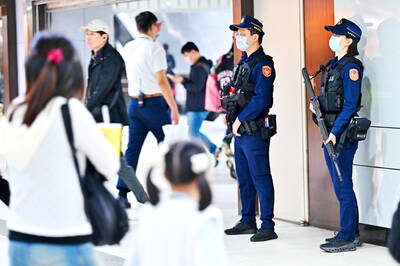Pakistan yesterday successfully test fired its Ghauri intermediate-range ballistic missile, an army spokesman said.
The Ghauri, first tested in April 1998, can hit targets as far away as 1,500km and is capable of carrying nuclear and conventional warheads.
The missile successfully hit its target about 900km away from the launching site and carried an 800kg payload, Major General Shaukat Sultan said.
Prime Minister Mir Zafarullah Khan Jamali, who witnessed the missile test, congratulated the scientists, engineers and staff on their "unique technical success."
"Pakistan's policy of maintaining minimum credible deterrence as a cornerstone of its national security policy had been conceived after much thought and care and stood the test of time," a statement by Inter Service Public Relations (ISPR) quoted him as saying after the test.
Jamali made it clear that Pakistan's edge over "its adversaries in the strategic field" will be maintained at all costs.
He promised to provide the resources to maintain the quality of the nation's deterrence.
The missile tested yesterday was second in range only to the Shaheen-2, which was tested in March this year with a capacity of 2,000km.
Sultan said yesterday's test was aimed at improving the parameters of the missile and that all neighboring countries had been informed of the test beforehand.
In the past, all of Pakistan's medium-range missiles were fired from a site about 120km east of Islamabad.
The Ghauri missile system was introduced into the Army Strategic Forces Command early last year along with the Shaheen-1 and Ghazanvi ballistic missile systems.
Foreign defense observers said they suspected Ghauri was originally based on technology used in the North Korean Nodong missile. Islamabad said it was an indigenous effort.
Meanwhile, Japan expressed regret over the test. "It is deeply regrettable that Pakistan conducted the test despite efforts by the international community for non-proliferation of weapons of mass destruction (WMD) and ballistic missiles," said a statement issued by the Japanese embassy in Islamabad yesterday.

TRAGEDY STRIKES TAIPEI: The suspect died after falling off a building after he threw smoke grenades into Taipei Main Station and went on a killing spree in Zhongshan A 27-year-old suspect allegedly threw smoke grenades in Taipei Main Station and then proceeded to Zhongshan MRT Station in a random killing spree that resulted in the death of the suspect and two other civilians, and seven injured, including one in critical condition, as of press time last night. The suspect, identified as a man surnamed Chang Wen (張文), allegedly began the attack at Taipei Main Station, the Taipei Fire Department said, adding that it received a report at 5:24pm that smoke grenades had been thrown in the station. One man in his 50s was rushed to hospital after a cardiac arrest

SAFETY FIRST: Double the number of police were deployed at the Taipei Marathon, while other cities released plans to bolster public event safety Authorities across Taiwan have stepped up security measures ahead of Christmas and New Year events, following a knife and smoke bomb attack in Taipei on Friday that left four people dead and 11 injured. In a bid to prevent potential copycat incidents, police deployments have been expanded for large gatherings, transport hubs, and other crowded public spaces, according to official statements from police and city authorities. Taipei Mayor Chiang Wan-an (蔣萬安) said the city has “comprehensively raised security readiness” in crowded areas, increased police deployments with armed officers, and intensified patrols during weekends and nighttime hours. For large-scale events, security checkpoints and explosives

PUBLIC SAFETY: The premier said that security would be tightened in transport hubs, while President Lai commended the public for their bravery The government is to deploy more police, including rapid response units, in crowded public areas to ensure a swift response to any threats, President William Lai (賴清德) said yesterday after a knife attack killed three people and injured 11 in Taipei the previous day. Lai made the remarks following a briefing by the National Police Agency on the progress of the investigation, saying that the attack underscored the importance of cooperation in public security between the central and local governments. The attack unfolded in the early evening on Friday around Taipei Main Station’s M7 exit and later near the Taipei MRT’s Zhongshan

ON ALERT: Taiwan’s partners would issue warnings if China attempted to use Interpol to target Taiwanese, and the global body has mechanisms to prevent it, an official said China has stationed two to four people specializing in Taiwan affairs at its embassies in several democratic countries to monitor and harass Taiwanese, actions that the host nations would not tolerate, National Security Bureau (NSB) Director-General Tsai Ming-yen (蔡明彥) said yesterday. Tsai made the comments at a meeting of the legislature’s Foreign Affairs and National Defense Committee, which asked him and Minister of National Defense Wellington Koo (顧立雄) to report on potential conflicts in the Taiwan Strait and military preparedness. Democratic Progressive Party (DPP) Legislator Michelle Lin (林楚茵) expressed concern that Beijing has posted personnel from China’s Taiwan Affairs Office to its